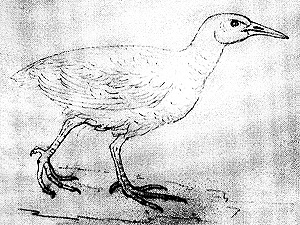Malaspina’s Rail (Gallirallus sp.)
This form is known from a drawing that was made on an island of the Vava’u group, probably ‘Uta Vava’u, during the so-called ‘Malaspina Expedition’, which visited the Pacific under the leadership of Alessandro Malaspina di Mulazzo, sometime between 1789 and 1794.
The brief description shows that the bird was bluish gray or ash gray in color, and that its plumage was less spotted or striped than most of the other species in the genus.
The species certainly died out a few years later. [1]
*********************

(public domain)
*********************
References:
[1] Storrs L. Olson: Birds, including extinct species, encountered by the Malaspina Expedition on Vava’u, Tonga, in 1793. Archives of Natural History, 33(1): 42-52. 2006
*********************
edited: 02.05.2021
